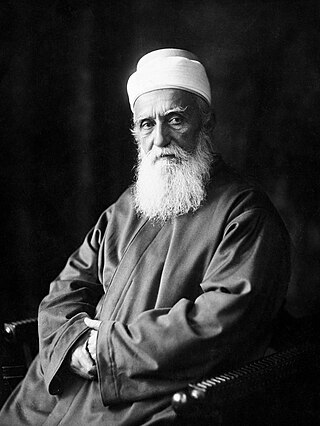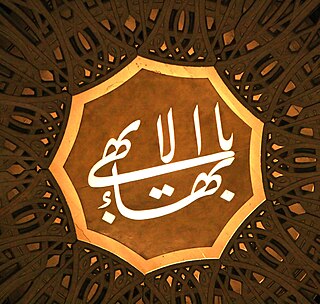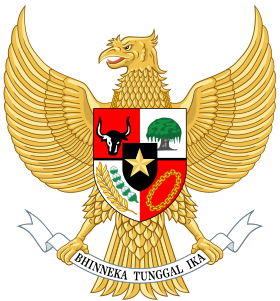
ʻAbdu'l-Bahá, born ʻAbbás, was the eldest son of Baháʼu'lláh and served as head of the Baháʼí Faith from 1892 until 1921. ʻAbdu'l-Bahá was later canonized as the last of three "central figures" of the religion, along with Baháʼu'lláh and the Báb, and his writings and authenticated talks are regarded as sources of Baháʼí sacred literature.
Covenant-breaker is a term used in the Baháʼí Faith to refer to a person who has been excommunicated from the Baháʼí community for breaking the Covenant of Baháʼu'lláh, meaning actively promoting schism in the religion or otherwise opposing the legitimacy of the chain of succession of leadership. Excommunication among Baháʼís is rare and not used for transgressions of community standards, intellectual dissent, or conversion to other religions. Instead, it is the most severe punishment, reserved for suppressing organized dissent that threatens the unity of believers.

Shoghí Effendi (; 1 March 1897 – 4 November 1957) was the grandson and successor of ʻAbdu'l-Bahá, appointed to the role of Guardian of the Baháʼí Faith from 1921 until his death in 1957. He created a series of teaching plans that oversaw the expansion of the faith to many new countries, and also translated many of the writings of the Baháʼí central figures. He was succeeded by an interim arrangement of the Hands of the Cause until the election of the Universal House of Justice in 1963.

Bhinneka Tunggal Ika is the official national motto of Indonesia, inscribed in the National emblem of Indonesia, the Garuda Pancasila, written on the scroll gripped by the Garuda's claws. The phrase comes from the Old Javanese, translated to as "Unity in Diversity." The phrase is also mentioned in the Constitution of Indonesia, specifically in article 36A. The motto refers to the unity and integrity of Indonesia, a nation consisting of various cultures, regional languages, races, ethnicities, religions, and beliefs.
Hand of the Cause was a title given to prominent early members of the Baháʼí Faith, appointed for life by the religion's founders. Of the fifty individuals given the title, the last living was ʻAlí-Muhammad Varqá who died in 2007. Hands of the Cause played a significant role in propagating the religion, and protecting it from schism.
The following is a basic timeline of the Bábí and Baháʼí religions emphasizing dates that are relatively well known. For a more comprehensive chronology of the timeline, see the references at the bottom.
The Baháʼí administration is a system of elected and appointed institutions to govern the affairs of the Baháʼí community. Its supreme body is the Universal House of Justice, elected every five years.

In the Baháʼí Faith there are two covenants, deemed the 'greater' and 'lesser'. The greater covenant refers to an agreement of progressive revelation: that God will send messengers about every thousand years, and it is humanity's duty to recognize them and respond to their teachings. The lesser covenant is the agreement between the faith's founder, Baháʼu'lláh, and his followers, regarding the succession of leadership and the maintenance of unity.
Spiritual Assembly is a term given by ʻAbdu'l-Bahá to refer to elected councils that govern the Baháʼí Faith. Because the Baháʼí Faith has no clergy, they carry out the affairs of the community. In addition to existing at the local level, there are national Spiritual Assemblies. Spiritual Assemblies form part of the elected branch of the Baháʼí administration.
Progressive revelation is a core teaching in the Baháʼí Faith that suggests that religious truth is revealed by God progressively and cyclically over time through a series of divine Messengers, and that the teachings are tailored to suit the needs of the time and place of their appearance. Thus, the Baháʼí teachings recognize the divine origin of several world religions as different stages in the history of one religion, while believing that the revelation of Baháʼu'lláh is the most recent, and therefore the most relevant to modern society.
The Manifestation of God is a concept in the Baháʼí Faith that refers to what are commonly called prophets. The Manifestations of God are appearances of the Divine Spirit or Holy Spirit in a series of personages, and as such, they perfectly reflect the attributes of the divine into the human world for the progress and advancement of human morals and civilization through the agency of that same Spirit.
The Baháʼí Faith was formed in the late 19th-century Middle East by Baháʼu'lláh, and teaches that an official line of succession of leadership is part of a divine covenant that assures unity and prevents schism. There are no major schisms in the Baháʼí Faith, and attempts to form alternative leadership have either become extinct with time or have remained in extremely small numbers that are shunned by the majority. The largest extant sect is related to Mason Remey's claim to leadership in 1960, which has continued with two or three groups numbering at most 200 collectively, mostly in the United States.

There are several symbols used to express identification with the Baháʼí Faith: the nine-pointed star, a calligraphy known as the "Greatest Name", the Ringstone Symbol, or a five-pointed star.
The Baháʼí teachings represent a considerable number of theological, ethical, social, and spiritual ideas that were established in the Baháʼí Faith by Baháʼu'lláh, the founder of the religion, and clarified by its successive leaders: ʻAbdu'l-Bahá, Baháʼu'lláh's son, and Shoghi Effendi, ʻAbdu'l-Bahá's grandson. The teachings were written in various Baháʼí writings. The teachings of the Baháʼí Faith, combined with the authentic teachings of several past religions, are regarded by Baháʼís as revealed by God.
Unity of humanity is one of the central teachings of the Baháʼí Faith. The Baháʼí teachings state that since all humans have been created in the image of God, God does not make any distinction between people regardless of race or colour. Thus, because all humans have been created equal, they all require equal opportunities and treatment. Thus the Baháʼí view promotes the unity of humanity, and that people's vision should be world-embracing and that people should love the whole world rather than just their nation. The teaching, however, does not equate unity with uniformity, but instead the Baháʼí writings advocate for the principle of unity in diversity where the variety in the human race is valued.
The Apostles of Baháʼu'lláh were nineteen prominent early followers of Baháʼu'lláh, the founder of the Baháʼí Faith. The apostles were designated as such by Shoghi Effendi, head of the religion in the earlier half of the 20th century, and the list was included in The Baháʼí World, Vol. III (pp. 80–81).
Baháʼí literature covers a variety of topics and forms, including scripture and inspiration, interpretation, history and biography, introduction and study materials, and apologia. Sometimes considerable overlap between these forms can be observed in a particular text.
The phrase "new world order" in the Baháʼí Faith refers to the replacement of the collective political norms and values of the 19th century with a new system of worldwide governance that incorporates the Baháʼí ideals of unity and justice for all nations, races, creeds, and classes. The idea of world unification, both politically and spiritually, is at the heart of Baháʼí teachings.

Hinduism is recognized in the Baháʼí Faith as one of nine known religions. Krishna is included in the succession of Manifestations of God.
The following outline is provided as an overview of and topical guide to the Baháʼí Faith.








